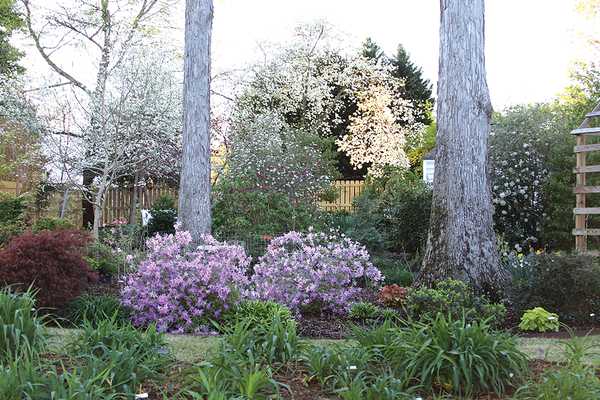This preamble is by Sue Ercolini in loving memory of Judy:
Do you ever wonder why some of us love to garden but others can ‘create’ a garden wonderland? My friend Judy was one such talented and creative individual in all aspects of her life, but gardening was her passion. Her gardening interest started as a young girl growing zinnias from seeds in her parent’s backyard. She married her childhood sweetheart, Jim and together they designed and created many gardens…the last being ‘Three Oaks’. They have won several garden awards including ‘Best Garden’ and have been featured in Professor Oliver Billingslea ´s book on international gardens, ´Landscaping with Daylilies´. These featured photos are of ´Three Oaks´ where you will still find Jim gardening.
The following Garden Design article was written by Judy over a decade ago for Framingham Garden Club in Massachusetts. These design elements are the same today and can be used for starting a new garden area, re-doing your garden or just starting from scratch.
Judy’s Garden Design…I would like to introduce all of you to the world of garden design. In my opinion, garden design is much more than a study course but rather a hands-on, and more importantly, a heartfelt labor of love of nature. In creating a garden I find peace and hope; Peace, in those morning sunrises peeking through the trees in my shade garden…Hope, in the blue Clematis petals opening for the first time.
As you wander through a backyard garden or tour a professionally developed garden, absorb the feeling created and see the various shapes, textures and colors used to create that feeling. Don’t be overwhelmed by the whole picture. Visualize each section and how it develops into a whole garden. Designing and building a garden is, to me, a very individual and personal experience. I have never seen two gardens look alike. Have You? There may be a few basic rules but the interpretation is as varied as the oil colors on a painter’s canvas or the shapes and colors of a quilter’s squares.
If you are starting with a new yard or a yard that bears the medals or scars from previous owners, here are some basic rules that will help keep you focused:
- What kind of hardscape (footpaths, concrete pads, walls, fountains, birdbaths, lamp posts, walk lighting, sheds, fencing etc.) exists and what would I like?
- What canopies (trees and shrubs that provide shade) exist and how can I use them to provide for shade for plants and people?
- How will I use the various areas of the garden? Play areas for children, party areas, ponds, bogs, peace and contentment area, cutting garden, woodland area, vegetable garden, etc. These are sometimes called rooms.
- What do I like to grow?
Before I get into any of these areas, I want to mention that soil, soil, soil is the most important factor in a successful garden! Have your local agricultural extension test your soil. Follow the instructions on the sample bag they provide, tell them you are growing corn (your analysis will be more complete) and mail it in. Your plants will love you for it. Take pictures of the garden before you start and as you progress through your creation.
Hardscape: Take into account the sizes of what currently exists and keep in mind the proportions of the hardscape you’re contemplating and the size of your garden. Try to put curves into your paths and walks. Make sure you have electricity installed if you want a fountain. If you can afford it, have a water line run to the back of the garden or buy a good quality hose and hose reel so that you can reach all parts of a garden. If you can afford to spend thousands of dollars for an irrigation system then go for it. You want all underground and pond work done before you work your soil. Most hardscaping on the surface can be done after the growing spaces are established. Don’t be afraid to make use of used materials found in recycle or used architectural establishments.
Canopies: Canopies are the large trees and shrubs that provide the bones for the garden. Remove the damaged and rotting ones before doing any soil prep and hardscaping. Get pros to handle the large ones if any.
Garden Uses: Do you entertain in your garden? Do you need a safe area in the garden for children to play and will you be able to see it from a room in the house you frequent? Do you plan on a vegetable garden? Cutting garden? Bog Garden? Naturalizing area? Area to sit and have refreshment alone or with company? Remember, this is your garden. Make note of how the Sun tracks overhead so that your planting areas get the sun or shade they need to thrive. You make your garden what you want and with what you can afford. And always remember the saying that Rome was not built in a day!
What do You Want to Grow: Grow what gives YOU pleasure. Native plants? Cutting garden? Perennials? Specialty plants like roses, daylilies, Japanese maples, evergreen trees, tall grasses, bulbs and roots, bog plants? All of the above?
If you’re about to hyperventilate and are thinking “Uh Oh, this is too hard”; don’t fret. Once you have made notes of what you want, get a large piece of freezer paper or such and make an outline of the borders of your garden. You can scale it to ½ or ¼ inch but a rough sketch will work, too. Roughly sketch in the areas that you want your garden to have and put names to them. Divide the sections into phases of completion. Which ones do you want first and most and which are long range. Example: Phase 1; remove unwanted plants trees, grass and hardscape. Phase 2; install shed, irrigation, electricity, water line, border fences. Phase 3; Plant structure and background plants like trees and shrubs. Phase 4; plant perennials ground covers, and annuals.
I have been gardening for over 50 years and in that time have created eight complete gardens; each unique to its location. Of the eight gardens, four were at new houses with the soil scraped clean and four were at older houses with yards overrun by the plantings. Each one had a different feel to me and it is interesting to note that my first ideas for each one were not always my best ones. It was better for me and possibly for you to absorb yourself in the surroundings that you intend to be your garden. First, find the good qualities that currently exist and work from there. Don’t be too hasty to wipe the slate clean. I think the only time that you can be certain that “It’s got to go!” is when you have those overgrown foundation plantings that the contractors installed when the house was built; those plants that seem to be devouring the house. Your planning will become clearer as you get to know your yard.
If you do not want to do it yourself and can afford to have professionals do it, then do that. Still, be prepared to tell them what you want by following the above guidelines so you get the results that you want. And don’t forget that potted plants can add another dimension to a garden.



